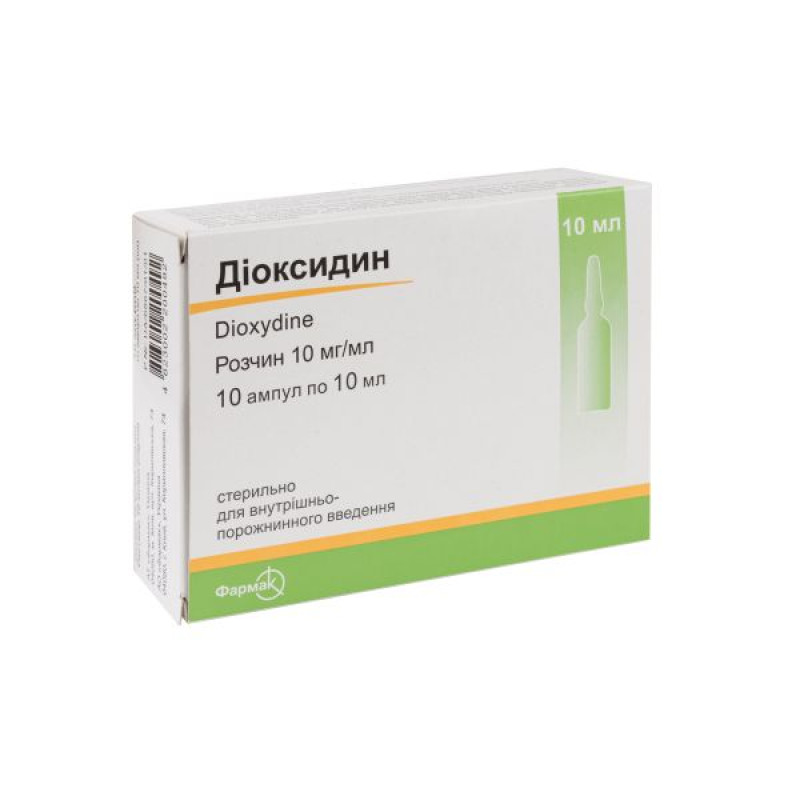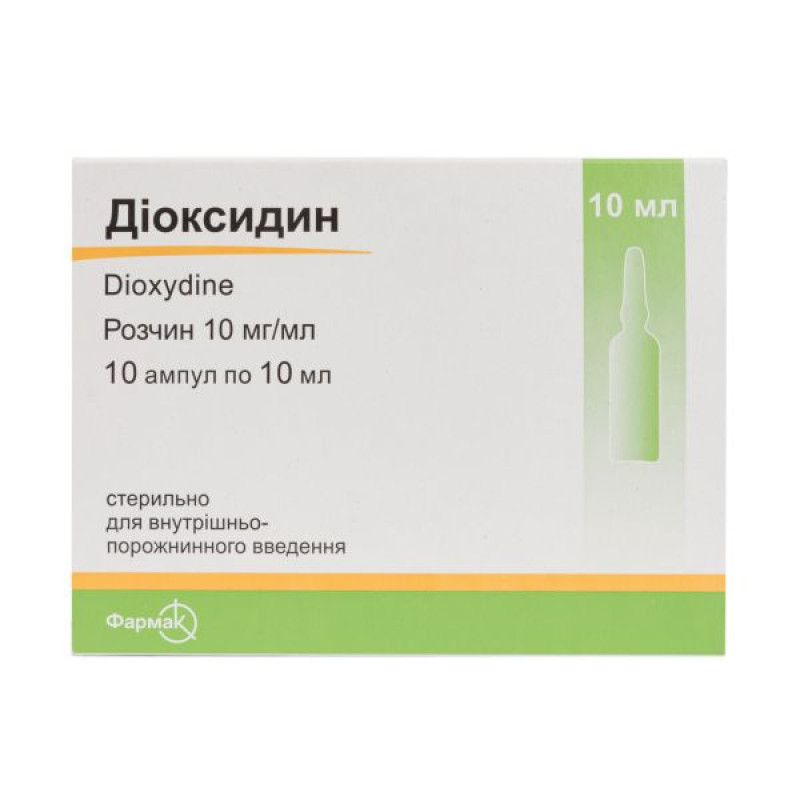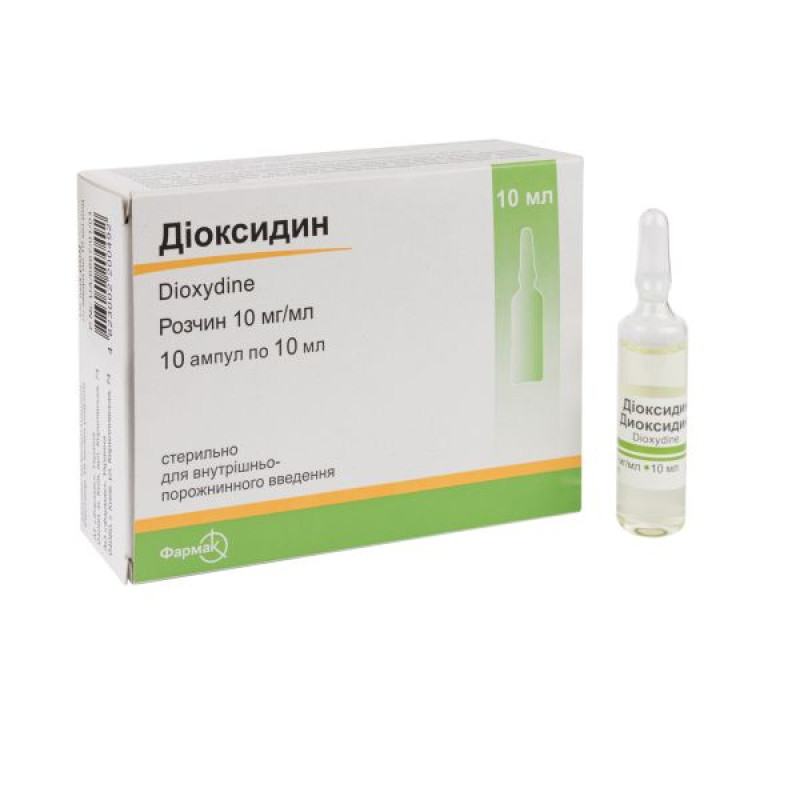Dioxidine solution 10 mg/ml ampoule 10 ml No. 10

Instructions Dioxidin solution 10 mg/ml ampoule 10 ml No. 10
Composition
active ingredient: dioxidine;
1 ml of solution contains 10 mg of dioxidine in terms of 100% substance;
excipients: water for injections.
Dosage form
Solution.
Main physicochemical properties: transparent greenish-yellow liquid.
Pharmacotherapeutic group
Antibacterial agents. ATX code J01X X.
Pharmacological properties
Pharmacodynamics
Dioxidine is a broad-spectrum antibacterial drug. It is effective in infections caused by Proteus vulgaris, Pseudomonas aeruginosa, Friedlander's bacillus, Escherichia coli, dysentery bacillus, salmonella, staphylococci, streptococci, pathogenic anaerobes, including gas gangrene pathogens. It is active against strains of bacteria resistant to antibiotics, sulfonamides, nitrofurans and other drugs.
Pharmacokinetics
When applied topically, dioxidine is partially absorbed, does not have a local irritant effect. Does not undergo metabolism. Does not accumulate. Excreted by the kidneys.
Indication
Purulent-inflammatory processes of various localization: purulent pleurisy, pleural empyema, lung abscess, peritonitis, cystitis, wounds with deep cavities, soft tissue abscesses, phlegmons, postoperative wounds of the urinary and biliary tract. Also used for the prevention of infectious complications after bladder catheterization.
Contraindication
Individual intolerance to the drug, adrenal insufficiency (including a history).
Interaction with other medicinal products and other types of interactions
Not described.
Application features
Dioxidine is used in hospital settings. Experimentally, the teratogenic and embryotoxic effects of the drug have been revealed (therefore, it is contraindicated during pregnancy); the drug also has a mutagenic effect. In this regard, Dioxidine is prescribed only for severe forms of infectious diseases or when other antibacterial drugs, including cephalosporins of the II–IV generations, fluoroquinolones, carbapenems, are ineffective. Uncontrolled use of Dioxidine and dosage forms containing it is not allowed.
Use with caution in renal failure; reduce the dose in chronic renal failure.
If pigment spots appear, the duration of the dose is increased to 1.5–2 hours, the dose is reduced, antihistamines are prescribed, and if necessary, the drug is discontinued.
Use during pregnancy or breastfeeding
The drug is contraindicated for use during pregnancy or breastfeeding.
Ability to influence reaction speed when driving vehicles or other mechanisms
During the treatment period, caution should be exercised when driving vehicles or engaging in other potentially hazardous activities that require increased concentration and speed of psychomotor reactions.
Method of administration and doses
Dioxidine is prescribed only for adults.
Before starting the course of treatment, it is necessary to conduct a drug tolerance test, for which 10 ml of 1% solution is injected into the purulent cavity. In the absence of side effects (dizziness, chills, fever) within 3-6 hours, course treatment is started. The solution is injected into the cavity through a drainage tube, catheter or syringe - usually 10-50 ml of 1% solution. The maximum daily dose is 70 ml of 1% solution. Apply 1 or 2 times a day (not exceeding the daily dose of 70 ml of 1% solution). The duration of treatment depends on the severity of the disease and the tolerability of the drug. The course of treatment can last 3 weeks or more. If necessary, repeat the course of treatment after 1-1.5 months.
It is also applied topically, applying bandages moistened with a 1% solution to the wound surface.
Children
The drug is not used to treat children.
Overdose
The development of acute adrenal insufficiency is possible.
Treatment: immediate discontinuation of the drug, appropriate hormone replacement therapy.
Adverse reactions
With intracavitary administration, headache, chills, increased body temperature, dyspeptic disorders, convulsive muscle contractions, allergic reactions, photosensitizing effect (the appearance of pigment spots on the body when exposed to sunlight) are possible.
When used externally – periwound dermatitis, itching.
Expiration date
4 years.
Do not use the drug after the expiration date indicated on the package.
Storage conditions
Store in a place protected from light at a temperature of 18 ° C to 25 ° C. Keep out of the reach of children.
In case of precipitation of dioxidine crystals in ampoules during storage (at a temperature below 15 °C), they are dissolved by heating the ampoules in a boiling water bath with shaking until the crystals are completely dissolved (transparent solution). If the crystals do not precipitate again upon cooling to (37 ± 1) °C, the drug is suitable for use.
Packaging
10 ml in an ampoule. 10 ampoules in a pack.
Vacation category
According to the recipe.
Producer
JSC "Farmak".
Location of the manufacturer and its business address
Ukraine, 04080, Kyiv, Kyrylivska St., 74.
There are no reviews for this product.
There are no reviews for this product, be the first to leave your review.
No questions about this product, be the first and ask your question.








